
1. With which processes should we start robotization in health and pharmacy?
Answer: We can start the robotization process in companies operating in the health and pharmacy industry with: checking the inventory of medicines, booking invoices in ERP systems, handling ordering processes and verifying the status of shipments.
2. How many elements does the simplest possible robot consist of?
Answer: The simplest possible robots are based on several function blocks. Imagine a useful robot based on a single copy-paste instruction. However, in order for the robot to be safely run, it needs the necessary modules related to, among others with error handling, logging, parameterization.
3. Is there a limit to expanding a single robot?
Answer: In theory – there is no such limit. The robot can be expanded and updated with new functionalities. In practice, we are only limited by our imagination and common sense. The more complex the robot is, the more its maintenance costs increase.
4. Where to get knowledge about robotization?
Answer: There are many opportunities to develop your knowledge of robotization. We encourage you to read not only the Robotics University or the blog run by Digital Teammates. The websites of official robotic platforms, reports of consulting companies, the English-language NewsNow website and Polish Robonomika are also noteworthy.
5. Do you need to have an IT education to deal with robotization of processes?
Answer: Not. Our Robo Shepherds are the best example. No industry education (IT) is required to deal with the robotization of business processes and to successfully model and automate tasks.
6. What are Robo Shepherds responsible for?
Answer: The Robo Shepherd is not only an RPA developer. They are also responsible for:
7. Are there aspects of work where robots have an advantage over people?
Answer: Robots are definitely more efficient than humans. They can work 24 hours a day, all days of the week and are great at dealing with work congestion. They never make mistakes and their technical failures are rare. At the same time, robots are cheaper than humans and can work continuously.
8. What are the components of the TCA indicator?
Answer: TCA, i.e. the total cost of robotization, consists of: organizational costs – expenses consciously incurred to implement and develop RPA in the company and technological costs – i.e. those related to equipment, licenses and infrastructure.
9. How many jobs can the robot replace?
Answer: A robot can replace virtually any number of human jobs, especially if we have a suitably flexible technical infrastructure, e.g. cloud.
10. What is BPM?
Answer: BPM, or Business Process Management, is a way of managing an organization, the purpose of which is to optimize the course of processes.
11. What is BPMN?
Answer: BPMN, or Business Process Modeling & Notation, is a formalized method for creating and modeling business processes.
12. What is BPMS?
Answer: BPMS, or Business Process Management System, refers to systems whose task is to support the implementation of business process management in a company.
13. How many companies are currently using RPA solutions?
Answer: Currently, many corporations, large companies and small and medium-sized enterprises use Robotic Process Automation solutions. Indication of a specific number of companies is extremely difficult because the number of companies implementing robots is constantly growing. Referring to a Pegasystems survey of 3,158 senior employees in the Americas, EMEA and Asia-Pacific regions, 67% of organizations now invest in RPA.
14. Is RPA a new technology?
Answer: Although the term “RPA” appeared at the beginning of the 21st century, the very process of implementing business process automation began in the 1990s. Since the emergence of the currently leading RPA platforms, i.e. after 2010, one can certainly speak of RPA as a mature technology.
15. Which industry has the most robotic processes?
Answer: Currently, the robotization of business processes is most popular in industries such as banking, insurance and finance.





